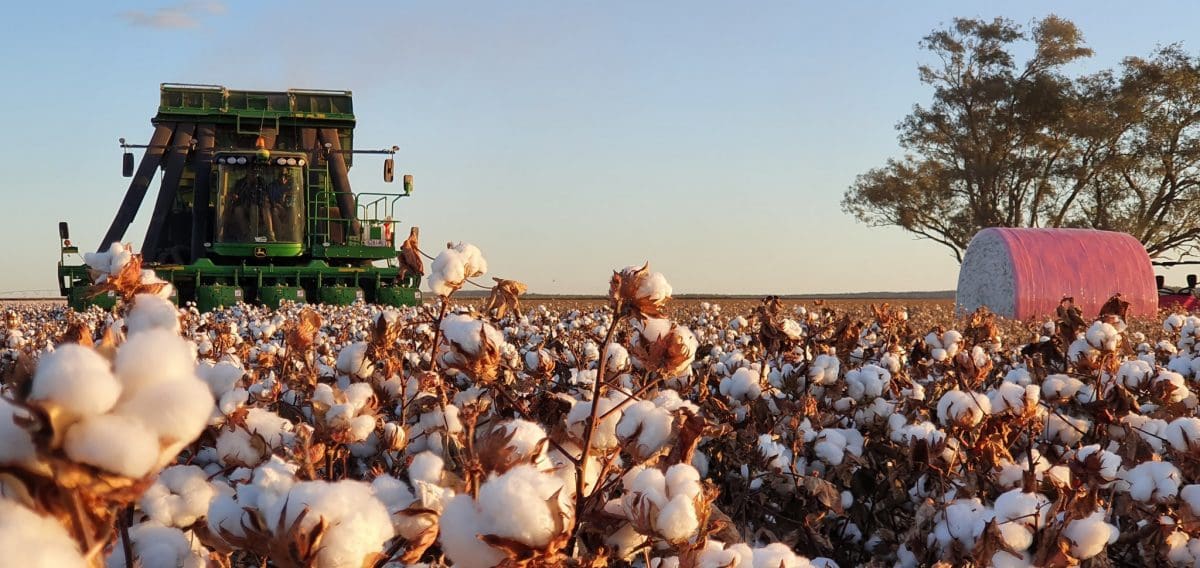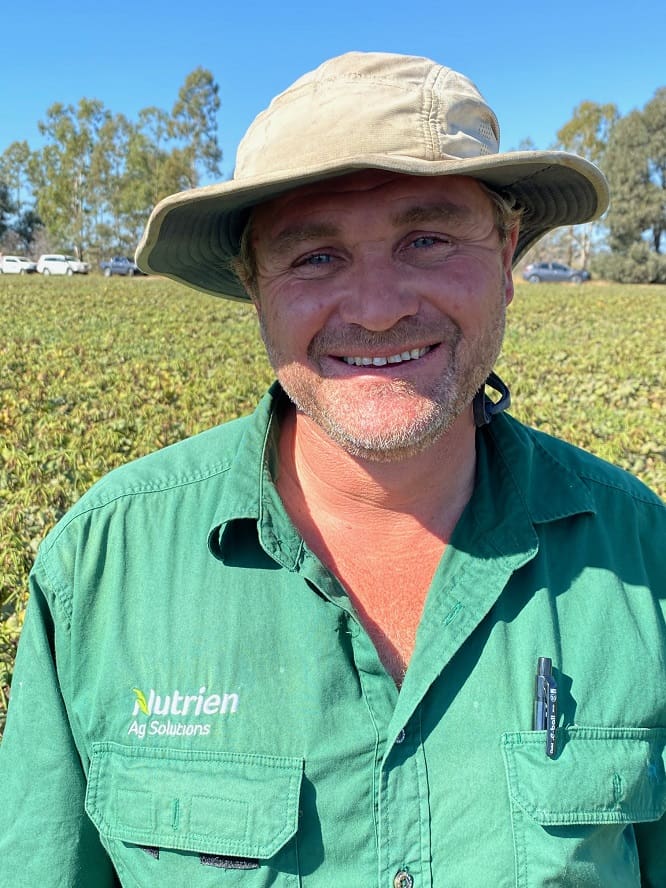
Cotton picker harvesting this season’s crop in Queensland’s Central Highlands. (Photo: Renee Anderson)
COTTON Australia has nudged up its estimate for this season’s cotton production to “2.7 million bales and rising” as pickers move through crops from Central Queensland to southern New South Wales.
Chief executive officer, Adam Kay, said above-expected production levels in some areas had prompted the increase from earlier forecasts of 2.6 million bales.
“We are starting to hear yield results coming in from places like St George and Dirranbandi where yields are above average. When we factor that in, plus there are some very good late dryland crops, that goes well for adding in some more,” he said.
“You can contrast that with the last couple of years when growers were running short of water. It is a wonderful situation to see more than we predicted being harvested.
“A couple of growers have reported to me that they thought the rain in March might impact the fibre, but with the weather we have had since then the bolls have really fluffed out and boll rot wasn’t as bad as we thought it might be.”
Central Queensland
In Central Queensland where the majority of picking is completed, Cotton Australia deputy chair and local grower, Nigel Burnett, said this year’s crop was a mixed bag.
He said while some crops had yielded up around 12-13 bales/hectare, others had been adversely impacted by rains in February.
“It all depended on whether the cotton was grown on or whether it was taken through to a picker at that stage. The cotton that was taken through to a picker was badly affected by the rain. The yield backed off and the quality was affected,” he said.
“But a lot of the cotton that has gone on and been harvested in the last couple of weeks – and the cotton still to be harvested – is shaping up well.
“We had up to 150 millimetres of rain in February which affected the cotton that was ready to be picked, but the cotton that people chose to grow on was favourably impacted with yield and quality. Because it has been so dry since then there will be a lot of white cotton mixed in with any cotton that was impacted by the rain.”
Southern Queensland
On the Darling Downs, Nutrien Ag Solutions agronomist, Ross Pomroy, Dalby, said growers had started crop defoliation about a month ago and picking was now underway.

Ross Pomroy
“About two weeks ago they started to get into some picking in the first of the western areas and most of the dryland. Just recently we have started to get into picking the irrigation crops,” he said.
“There is still some defoliation to continue on some later crops which will potentially go for another month. We are pushing the crops later and later and developing as many nodes as possible. We are lengthening the flowering period to maximise the potential.
“We have had a cooler couple of months, so the crop has gradually been going through its motions. We have held a lot of good fruit on top of the plant and we are hoping to wait for some of those crops. But we are at the time when growers are looking at the date and saying it’s time to defoliate.”
Northern NSW
In northern NSW, Cotton Seed Distributors’ (CSD) Namoi Valley extension and development agronomist, Bob Ford, said crops were later this year and picking had started later than usual in the last 10 days of April.
“The crops are two to three weeks later than they normally are because of the wet, cool start we had which delayed everything,” he said.
“There were some early insect pressure that took a lot of fruit off the crop, then the crops had to compensate. Growers have had to wait for their crops to ripen.
“Luckily, the crop has put on a really good top crop with lots of bolls at the top of the crop. Yields, at this early stage, look reasonable. We thought it was going to be a rough year but the early indications are we are hitting the 12 to 13 bales/hectare mark.”
While the area planted to cotton was down this season, Mr Ford said rains over recent months had increased inflows into the region’s storages and held the promise of a bigger planting this coming season.
“Keepit Dam (on the Namoi River) took a long time to get going. But the last lot of rainfall in March really made things happen. It is at 65 per cent (capacity). Last year it was only 15 to 20pc,” he said.
“So, next year, with the savings they had with the rain a lot of irrigators didn’t have to irrigate much, it is going to be a full production year for the Namoi which could mean up to 65,000ha across the valley.”
Southern NSW
CSD southern NSW extension and development agronomist, Jorian Millyard, said crops throughout the region were later than usual and picking had barely started.
“Growers have done the second and third defoliant passes. Pickers will probably start late this week,” he said.
“The crop picked so far is going around 10.5-11 bales/ha. It is sitting in the gin yard, so we don’t what the quality will be like. Plantings were down, largely due to the high water price at the start of the season.”
Mr Millyard said the outlook for next season was looking more positive with a potential plant of around 80,000 hectares for the lower Lachlan, Murrumbidgee and Murray River growing region.
“Next season looks attractive because we are sitting on quite a strong cotton price and the water price has gone from $550-$600/megalitre to $25/megalitre which is extremely cheap,” he said.
Flood disaster package
Meanwhile, the Federal Government has confirmed that cotton growers in southern Queensland impacted by flooding in March can now access grants of up to $75,000 to help them recover.
Mr Kay said while the rain had been welcomed by many cotton growers, some in the Goondiwindi Regional Council area suffered extreme hardship, losing all their crops and farming infrastructure including fencing, sheds and pumps.
“In March when the rain began in southern Queensland most farmers celebrated because it helped finish crops off and provided much needed reserves for next season,” he said.
“When we heard of the extent of the flood damage in the Goondiwindi region, Cotton Australia sought government help and both Federal Minister for Emergency Management David Littleproud and Queensland Minister for Agricultural Industry Development and Fisheries and Minister for Rural Communities Mark Furner stood up and delivered for farmers.
“I know our growers will greatly appreciate the grant assistance which will help get them through to next year when hopefully they will have a much better season.”
Grain Central: Get our free cropping news straight to your inbox – Click here

HAVE YOUR SAY